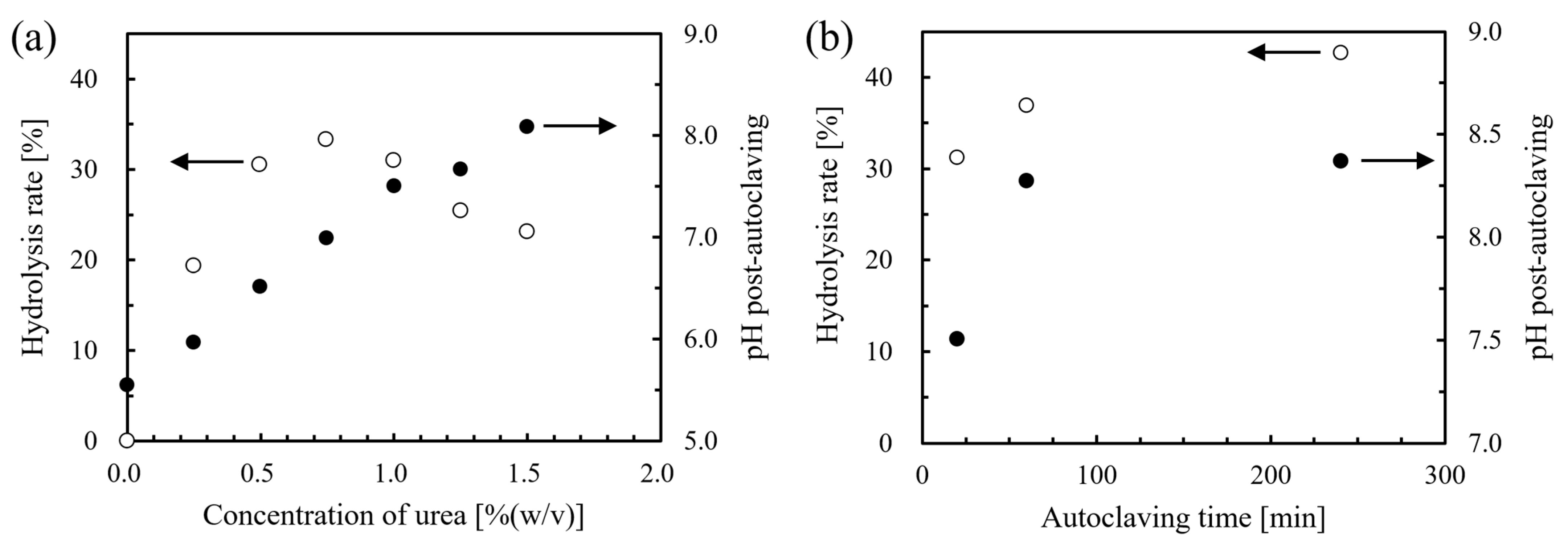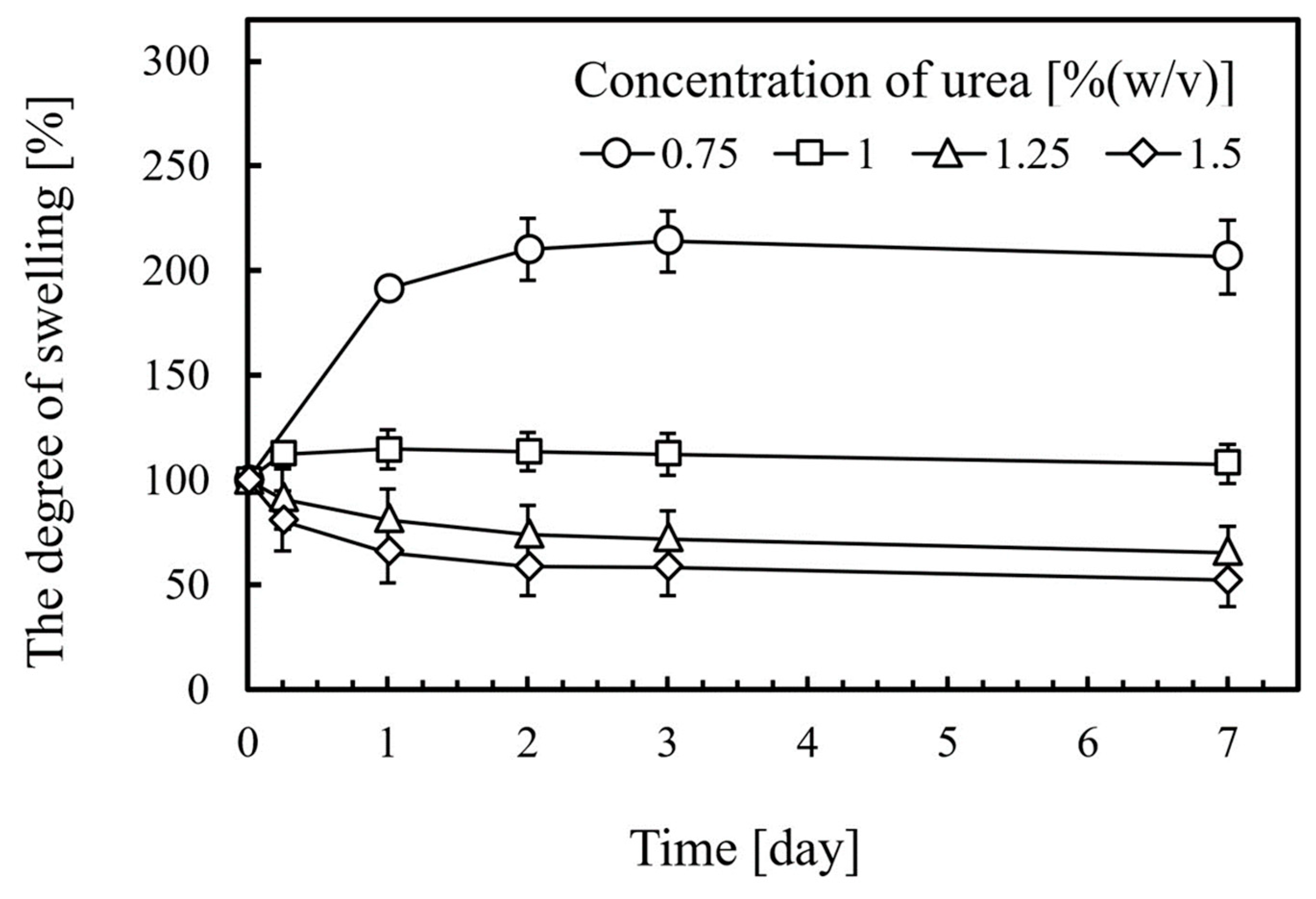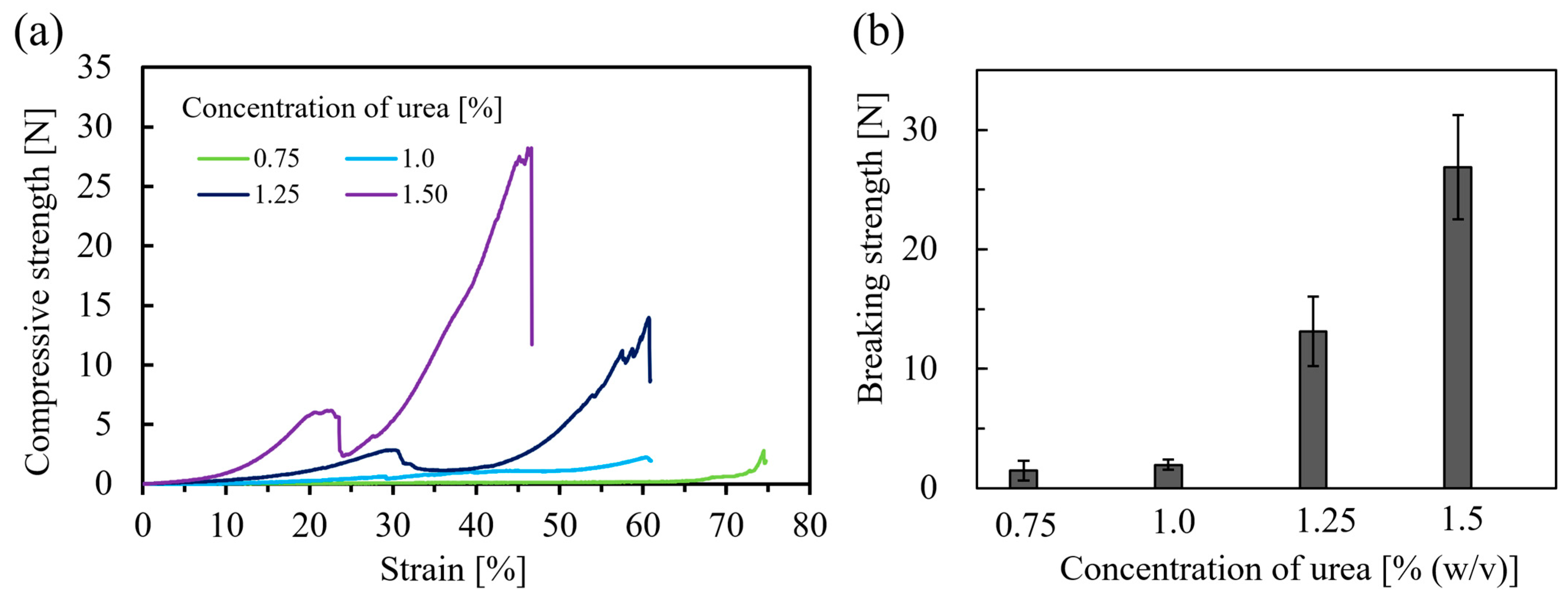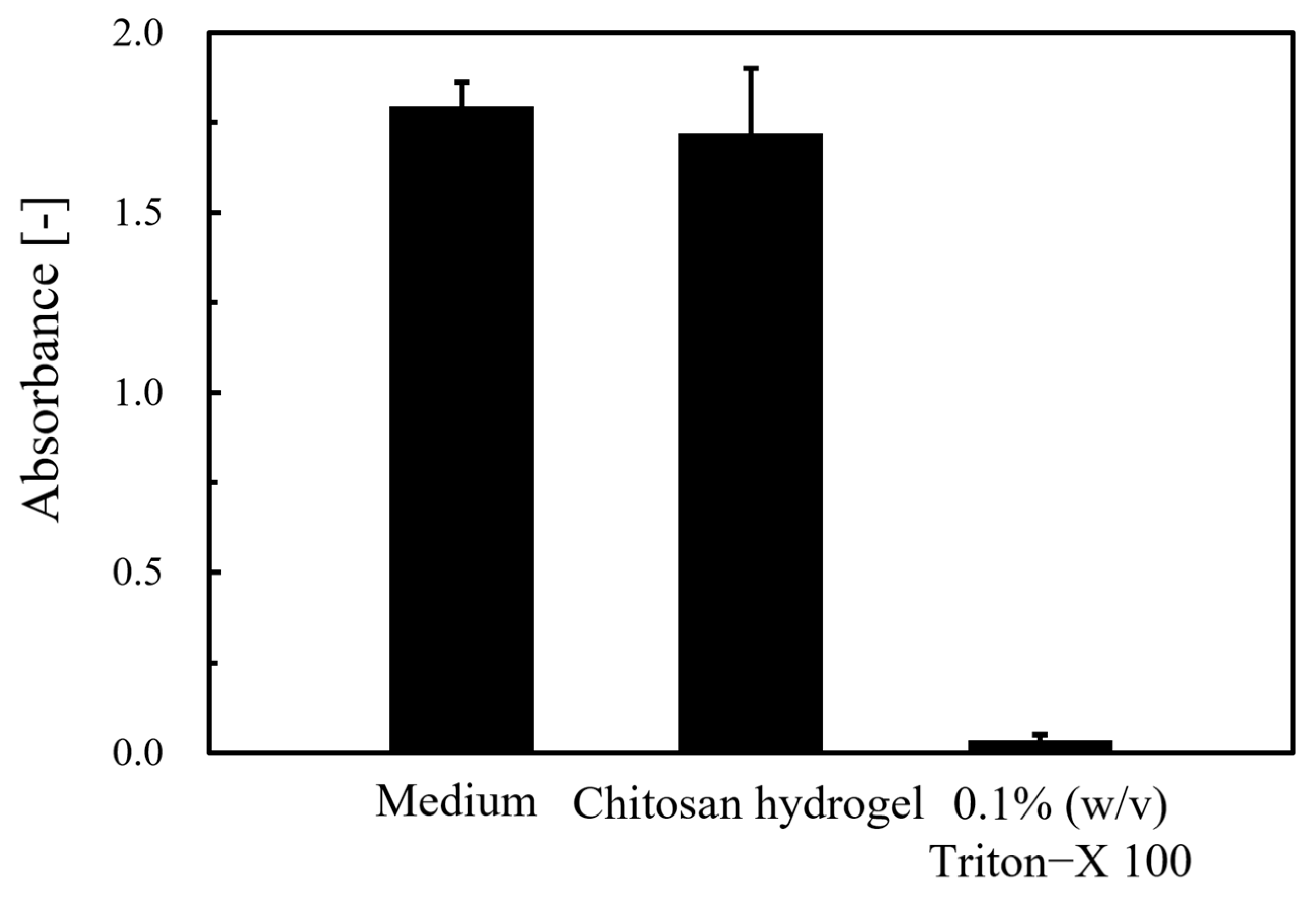Autoclaving Achieves pH-Neutralization, Hydrogelation, and Sterilization of Chitosan Hydrogels in One Step
Abstract
:1. Introduction
2. Materials and Methods
2.1. Materials
2.2. Preparation of Chitosan Hydrogels
2.3. The Rate of Hydrolysis of Urea and Osmotic Concentration
2.4. Evaluation of Swelling
2.5. Compression Test
2.6. Evaluation of Cytotoxicity
3. Results and Discussion
3.1. Preparation of Chitosan Hydrogels
3.2. Swelling Behavior
3.3. Mechanical Properties
3.4. Investigation of Whether the Chitosan Hydrogels Require Washing
3.5. Cytotoxicity of the Chitosan Hydrogels
4. Conclusions
Author Contributions
Funding
Institutional Review Board Statement
Data Availability Statement
Conflicts of Interest
Appendix A
References
- Rinaudo, M. Chitin and chitosan: Properties and applications. Prog. Polym. Sci. 2011, 31, 603–632. [Google Scholar] [CrossRef]
- Kumar, V.; Sharma, N.; Janghu, P.; Pasrija, R.; Umesh, M.; Chakraborty, P.; Sarojini, S.; Thomas, J. Synthesis and characterization of chitosan nanofibers for wound healing and drug delivery application. J. Drug Deliv. Sci. Technol. 2023, 87, 104858. [Google Scholar] [CrossRef]
- Tian, B.; Hua, S.; Liu, J. Multi-functional chitosan-based nanoparticles for drug delivery: Recent advanced insight into cancer therapy. Carbohydr. Polym. 2023, 315, 120972. [Google Scholar] [CrossRef]
- Liu, Z.; Xu, Y.; Su, H.; Jing, X.; Wang, D.; Li, S.; Chen, Y.; Guan, H.; Meng, L. Chitosan-base hemostatic sponges as new generation hemostatic materials for uncontrolled bleeding emergency: Modification, composition, and applications. Carbohydr. Polym. 2023, 311, 120780. [Google Scholar] [CrossRef]
- Zhao, J.; Qiu, P.; Wang, Y.; Zhou, J.; Zhang, B.; Zhang, L.; Gou, D. Chitosan-based hydrogel wound dressing: From mechanism to applications, a review. Int. J. Biol. Macromol. 2023, 244, 125250. [Google Scholar] [CrossRef]
- Yang, Y.; Ma, Y.; Wang, J.; You, L.; Zhang, R.; Meng, Q.; Zhong, S.; He, W.; Cui, X. Chitosan-based mussel-inspired hydrogel for rapid self-healing and high adhesion of tissue adhesion and wound dressings. Carbohydr. Polym. 2023, 316, 121083. [Google Scholar] [CrossRef]
- Liu, K.; Kang, Y.; Dong, X.; Li, Q.; Wang, Y.; Wu, X.; Yang, X.; Chen, H.; Dai, H. A simple yet effective hydrogel dressing for advanced microenvironmental management of diabetic wounds with intrinsic regulation. Chem. Eng. J. 2023, 470, 143987. [Google Scholar] [CrossRef]
- Shim, J.; Kang, J.; Yun, S.I. Chitosan-dipeptide hydrogels as potential anticancer drug delivery systems. Int. J. Biol. Macromol. 2021, 187, 399–408. [Google Scholar] [CrossRef]
- Kumara, B.N.; Gurudatt, N.G.; Prasad, K.S. Carboxymethyl-hexanoyl chitosan: A promising candidate for hydrophobic and hydrophilic drug delivery. Carbohydr. Polym. Technol. Appl. 2023, 6, 100401. [Google Scholar] [CrossRef]
- Takeya, H.; Itai, S.; Kimura, H.; Kurashina, Y.; Amemiya, T.; Nagoshi, N.; Iwamoto, T.; Sato, K.; Shibata, S.; Matsumoto, M.; et al. Schwann cell-encapsulated chitosan-collagen hydrogel nerve conduit promotes peripheral nerve regeneration in rodent sciatic nerve defect models. Sci. Rep. 2023, 13, 11932. [Google Scholar] [CrossRef]
- Yuan, X.; Wan, J.; Yang, Y.; Haung, L.; Zhou, C.; Su, J.; Hua, S.; Pu, H.; Zou, Y.; Zhu, H.; et al. Thermosensitive hydrogel for cartilage regeneration via synergistic delivery of SDF-1α like polypeptides and kartogenin. Carbohydr. Polym. 2023, 304, 120492. [Google Scholar] [CrossRef]
- Kaur, K.; Paiva, S.S.; Caffrey, D.; Cavanagh, B.L.; Murphy, C.M. Injectable chitosan/collagen hydrogels nano-engineered with functionalized single wall carbon nanotubes for minimally invasive applications in bone. Mater. Sci. Eng. C 2023, 128, 112340. [Google Scholar] [CrossRef]
- Hao, Y.; Zhao, W.; Zhang, H.; Zheng, W.; Zhou, Q. Carboxymethyl chitosan-based hydrogels containing fibroblast growth factors for triggering diabetic wound healing. Carbohydr. Polym. 2022, 287, 119336. [Google Scholar] [CrossRef]
- Yang, Z.; Wang, C.; Zhang, Z.; Yu, F.; Wang, Y.; Ding, J.; Zhao, Z.; Liu, Y. A pH responsive tannic acid/quaternized carboxymethyl chitosan/oxidized sodium alginate hydrogels for accelerated diabetic wound healing and real-time monitoring. Int. J. Biol. Macromol. 2024, 264, 130741. [Google Scholar] [CrossRef] [PubMed]
- Chen, Z.; Yuan, M.; Li, H.; Luo, B.; Lu, L.; Xiang, Q.; Ding, S. Succinylated chitosan derivative restore HUVEC cells function damaged by TNF-α and high glucose in vitro and enhanced wound healing. Int. J. Biol. Macromol. 2024, 265, 130825. [Google Scholar] [CrossRef] [PubMed]
- Shu, X.; Shu, J.; Wang, Y.; Deng, H.; Zhang, J.; He, J.; Wu, F. ROS-scavenging hydrogel to accelerate wound healing and reduce scar formation. Chem. Eng. J. 2023, 474, 145941. [Google Scholar] [CrossRef]
- Wang, M.; Lin, S.; Liu, M.; Jiao, J.; Mi, H.; Sun, J.; Liu, Y.; Guo, R.; Liu, S.; Fu, H.; et al. An injectable and rapidly degraded carboxymethyl chitosan/polyethylene glycol hydrogel for postoperative antiadhesion. Chem. Eng. J. 2023, 463, 142283. [Google Scholar] [CrossRef]
- Maiz-Fernádez, S.; Pérez-Álvarez, L.; Silván, U.; Vilas-Vilela, J.L.; Lanceros-Mendez, S. Photocrosslinkable and self-healable hydrogels of chitosan and hyaluronic acid. Int. J. Biol. Macromol. 2022, 216, 291–302. [Google Scholar] [CrossRef] [PubMed]
- Tran, D.L.; Le Thi, P.; Hoang Thi, T.T.; Park, K.D. Novel enzymatically crosslinked chitosan hydrogels with free-radical-scavenging property and promoted cellular behaviors under hyperglycemia. Prog. Nat. Sci. Mater. Int. 2020, 30, 661–668. [Google Scholar] [CrossRef]
- Takei, T.; Nakahara, H.; Ijima, H.; Kawakami, K. Synthesis of a chitosan derivative soluble at neutral pH and gellable by freeze–thawing, and its application in wound care. Acta Biomater. 2012, 8, 686–693. [Google Scholar] [CrossRef]
- Takei, T.; Danjo, S.; Sakoguchi, S.; Tanaka, S.; Yoshinaga, T.; Nishimata, H.; Yoshida, M. Autoclavable physically-crosslinked chitosan cryogel as a wound dressing. J. Biosci. Bioeng. 2018, 125, 490–495. [Google Scholar] [CrossRef] [PubMed]
- Yamashita, Y.; Ohzuno, Y.; Saito, Y.; Fujiwara, Y.; Yoshida, M.; Takei, T. Autoclaving-triggered hydrogelation of chitosan-gluconic acid conjugate aqueous solution for wound healing. Gels 2023, 9, 280. [Google Scholar] [CrossRef] [PubMed]
- Iqbal, M.A.; Sun, L.; Fedel, M. Synthesis of novel cone-shaped CaAl-LDH directly on aluminum alloy by a facile urea hydrolysis method. SN Appl. Sci. 2019, 1, 1415. [Google Scholar] [CrossRef]
- Uga, M.; Taniguchi, Y.; Matsumoto, M.; Okada, T.; Maeda, K.; Mieda, E.; Katakura, K.; Yamada, H. Development of novel decarboxylation-urea method toward interlayer-anion-controlled layered double hydroxides. ACS Omega 2023, 8, 36199–36206. [Google Scholar] [CrossRef] [PubMed]
- Madhumathi, K.; Sudheesh Kumar, P.T.; Kavya, K.C.; Furuike, T.; Tamura, H.; Nair, S.V.; Jayakumar, R. Novel chitin/nanosilica composite scaffolds for bone tissue engineering applications. Int. J. Biol. Macromol. 2009, 45, 289–292. [Google Scholar] [CrossRef]
- Takei, T.; Fukumoto, K.; Danjo, S.; Yoshinaga, T.; Nishimata, H.; Yoshida, M. In vitro and in vivo characterization of hydroxyapatite/chitosan-gluconic acid conjugate scaffolds. J. Chem. Eng. Jpn. 2017, 50, 577–582. [Google Scholar] [CrossRef]





| Concentration of Chitosan [% (w/v)] | Concentration of Urea [% (w/v)] | pH (Pre-Autoclaving) | pH (Post-Autoclaving) | Autoclaving Time [min] | Gelation | |
|---|---|---|---|---|---|---|
| a | 2.5 | 0.0 | 5.5 ± 0.0 | 5.5 ± 0.0 | 20 | − |
| b | 2.5 | 0.25 | 5.5 ± 0.0 | 6.0 ± 0.0 | 20 | − |
| c | 2.5 | 0.5 | 5.5 ± 0.0 | 6.5 ± 0.0 | 20 | − |
| d | 2.5 | 0.75 | 5.5 ± 0.0 | 7.0 ± 0.0 | 20 | + |
| e | 2.5 | 1.0 | 5.5 ± 0.0 | 7.5 ± 0.1 | 20 | + |
| f | 2.5 | 1.25 | 5.5 ± 0.0 | 7.7 ± 0.0 | 20 | + |
| g | 2.5 | 1.5 | 5.5 ± 0.0 | 8.1 ± 0.0 | 20 | + |
| h | 2.5 | 1.0 | 5.5 ± 0.0 | 8.3 ± 0.0 | 60 | + |
| i | 2.5 | 1.0 | 5.5 ± 0.0 | 8.4 ± 0.1 | 120 | + |
| Concentration of Urea [% (w/v)] | pH (Pre-Autoclaving) | pH (Post-Autoclaving) | Concentration of NH3 and NH4+ [mmol/L] | Osmotic Concentration [mOsm/L] | |
|---|---|---|---|---|---|
| a | 0.0 | 5.5 ± 0.0 | 5.5 ± 0.0 | 0 | 111 |
| b | 0.25 | 5.5 ± 0.0 | 6.0 ± 0.0 | 16 | 160 |
| c | 0.5 | 5.5 ± 0.0 | 6.5 ± 0.0 | 51 | 219 |
| d | 0.75 | 5.5 ± 0.0 | 7.0 ± 0.0 | 83 | 276 |
| e | 1.0 | 5.5 ± 0.0 | 7.5 ± 0.1 | 103 | 329 |
| f | 1.25 | 5.5 ± 0.0 | 7.7 ± 0.0 | 106 | 372 |
| g | 1.5 | 5.5 ± 0.0 | 8.1 ± 0.0 | 115 | 418 |
Disclaimer/Publisher’s Note: The statements, opinions and data contained in all publications are solely those of the individual author(s) and contributor(s) and not of MDPI and/or the editor(s). MDPI and/or the editor(s) disclaim responsibility for any injury to people or property resulting from any ideas, methods, instructions or products referred to in the content. |
© 2024 by the authors. Licensee MDPI, Basel, Switzerland. This article is an open access article distributed under the terms and conditions of the Creative Commons Attribution (CC BY) license (https://creativecommons.org/licenses/by/4.0/).
Share and Cite
Yamashita, Y.; Ohzuno, Y.; Yoshida, M.; Takei, T. Autoclaving Achieves pH-Neutralization, Hydrogelation, and Sterilization of Chitosan Hydrogels in One Step. Macromol 2024, 4, 376-386. https://doi.org/10.3390/macromol4020021
Yamashita Y, Ohzuno Y, Yoshida M, Takei T. Autoclaving Achieves pH-Neutralization, Hydrogelation, and Sterilization of Chitosan Hydrogels in One Step. Macromol. 2024; 4(2):376-386. https://doi.org/10.3390/macromol4020021
Chicago/Turabian StyleYamashita, Yusuke, Yoshihiro Ohzuno, Masahiro Yoshida, and Takayuki Takei. 2024. "Autoclaving Achieves pH-Neutralization, Hydrogelation, and Sterilization of Chitosan Hydrogels in One Step" Macromol 4, no. 2: 376-386. https://doi.org/10.3390/macromol4020021
APA StyleYamashita, Y., Ohzuno, Y., Yoshida, M., & Takei, T. (2024). Autoclaving Achieves pH-Neutralization, Hydrogelation, and Sterilization of Chitosan Hydrogels in One Step. Macromol, 4(2), 376-386. https://doi.org/10.3390/macromol4020021







